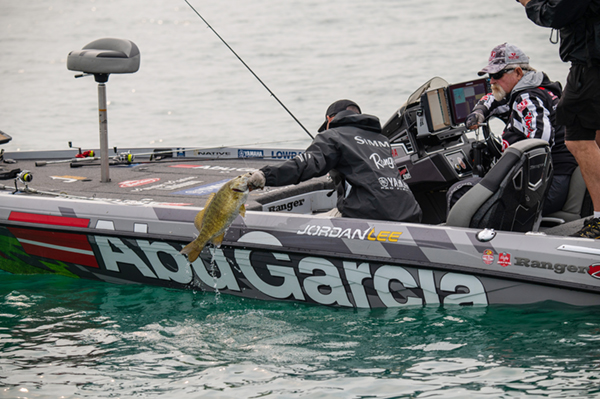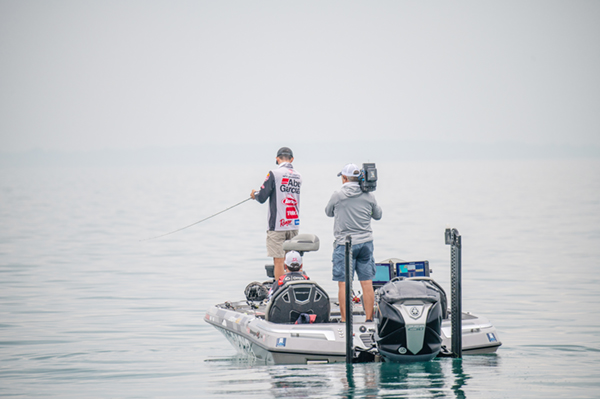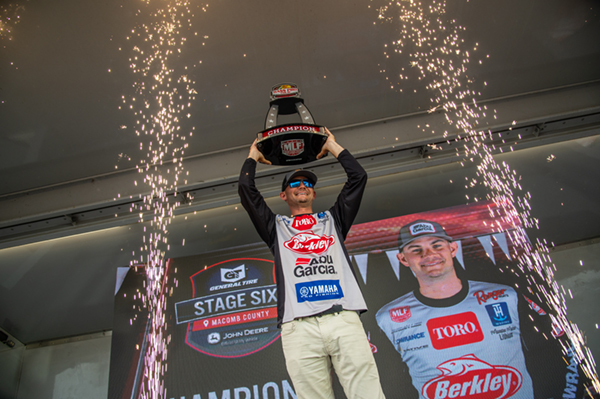It takes more than a succession of 100-degree days to keep Jordan Lee from going fishing, but the Yamaha Pro does admit the unusually hot temperatures this summer have forced him to change the way he searches for bass.
“As water temperatures climb into the high 80’s on many lakes around the country, bass react in fairly predictable ways,” notes the two-time Bassmaster Classic® winner, “and while fishermen need to limit their own time in the heat, they can still catch fish.

“The two primary considerations I have when I’m on the water in July and August are current and shade, and one or both of these are usually available on lakes and rivers everywhere.”
Current may be intermittent and depend on water releases from power-generating dams, so Lee tries to determine the generating schedule before he launches. It seldom continues throughout an entire day, but the current produced by these water releases can quickly turn inactive bass into active ones.
“The current will eventually move all the way down a lake, but I start by heading up the lake toward the dam where it will be strongest,” explains the Yamaha Pro. “I seldom go right into the tailrace area itself just below the dam because it doesn’t always have the highest population of bass, but I won’t be far away.

“You’ll see the current better in the upriver section portion of a lake along the shorelines. I like to look for water movement around brush, over any type of point, and especially near the mouths of small creeks or ditches. Bass position themselves in these types of places to be able to ambush forage as it comes past in the moving water.
”If the lake does not have current, or if he’s on the water waiting for power generation to start, Lee looks for shallow cover and shade. Boat docks are among his favorite targets, and sometimes they’re actually better during the middle of the day.
“I believe summer bass in shallow water have very definite feeding windows each day,” says Lee. “Frequently, these are early in the morning just around daylight, and again late in the afternoon. Most bass fishermen understand and take advantage of this, but what they may not realize is that when those shallow water bass stop biting, the fish have not moved to deeper water.
“They’re still there, but the feeding window has closed. The good thing about summer bass fishing is that there are always a few bass using shallow cover and shade, and they do not move around very much. When that early morning feeding bite stops, you can probably return to that same boat dock or lily pad cove early the next morning and catch fish again.”
“Because the late afternoon feeding window is often stronger, I’m not always in a hurry to get on the water in the morning, either,” he laughs.

The Yamaha Pro also suggests fishing vegetation on hot summer days, but he cautions that bass holding in hydrilla or milfoil do move frequently because these two types of vegetation change as they grow each day. Bass may be schooled along the edge of hydrilla one day but completely absent the next. Still, he notes, if vegetation is the dominant cover in a lake, then it’s certainly going to hold some bass.
Down-sizing to spinning tackle and using smaller lures with six or eight-pound test line can be an important part of summer success, Lee continues. Finesse-style presentations like drop-shotting with small soft plastics can represent an easy morsel that tempts even the most reluctant bass. Casting against the current so the lure can wash downstream naturally is one of his favorite hot weather techniques. Skipping soft plastics into shadow-filled boat docks also works well.
“Perhaps the most important thing to remember about fishing in extremely hot temperatures like we’ve been having is limiting your time on the water,” concludes the Yamaha Pro. “When the morning bite ends and that window closes, you’ll know it. Don’t stay out in the heat trying to force the bass to bite.
“It’s much better to get off the water and cool down, then be back on the water when the late afternoon feeding window opens.”
Back to Blue Life
“As water temperatures climb into the high 80’s on many lakes around the country, bass react in fairly predictable ways,” notes the two-time Bassmaster Classic® winner, “and while fishermen need to limit their own time in the heat, they can still catch fish.

“The two primary considerations I have when I’m on the water in July and August are current and shade, and one or both of these are usually available on lakes and rivers everywhere.”
Current may be intermittent and depend on water releases from power-generating dams, so Lee tries to determine the generating schedule before he launches. It seldom continues throughout an entire day, but the current produced by these water releases can quickly turn inactive bass into active ones.
“The current will eventually move all the way down a lake, but I start by heading up the lake toward the dam where it will be strongest,” explains the Yamaha Pro. “I seldom go right into the tailrace area itself just below the dam because it doesn’t always have the highest population of bass, but I won’t be far away.

“You’ll see the current better in the upriver section portion of a lake along the shorelines. I like to look for water movement around brush, over any type of point, and especially near the mouths of small creeks or ditches. Bass position themselves in these types of places to be able to ambush forage as it comes past in the moving water.
”If the lake does not have current, or if he’s on the water waiting for power generation to start, Lee looks for shallow cover and shade. Boat docks are among his favorite targets, and sometimes they’re actually better during the middle of the day.
“I believe summer bass in shallow water have very definite feeding windows each day,” says Lee. “Frequently, these are early in the morning just around daylight, and again late in the afternoon. Most bass fishermen understand and take advantage of this, but what they may not realize is that when those shallow water bass stop biting, the fish have not moved to deeper water.
“They’re still there, but the feeding window has closed. The good thing about summer bass fishing is that there are always a few bass using shallow cover and shade, and they do not move around very much. When that early morning feeding bite stops, you can probably return to that same boat dock or lily pad cove early the next morning and catch fish again.”
“Because the late afternoon feeding window is often stronger, I’m not always in a hurry to get on the water in the morning, either,” he laughs.

The Yamaha Pro also suggests fishing vegetation on hot summer days, but he cautions that bass holding in hydrilla or milfoil do move frequently because these two types of vegetation change as they grow each day. Bass may be schooled along the edge of hydrilla one day but completely absent the next. Still, he notes, if vegetation is the dominant cover in a lake, then it’s certainly going to hold some bass.
Down-sizing to spinning tackle and using smaller lures with six or eight-pound test line can be an important part of summer success, Lee continues. Finesse-style presentations like drop-shotting with small soft plastics can represent an easy morsel that tempts even the most reluctant bass. Casting against the current so the lure can wash downstream naturally is one of his favorite hot weather techniques. Skipping soft plastics into shadow-filled boat docks also works well.
“Perhaps the most important thing to remember about fishing in extremely hot temperatures like we’ve been having is limiting your time on the water,” concludes the Yamaha Pro. “When the morning bite ends and that window closes, you’ll know it. Don’t stay out in the heat trying to force the bass to bite.
“It’s much better to get off the water and cool down, then be back on the water when the late afternoon feeding window opens.”
Back to Blue Life
